Did you know that certain plants can act as natural pest shields in your garden? You can build a pest-resistant space by choosing smart plant pairings, like marigolds near tomatoes, to deter bugs. Start with a small 4×4 foot plot, spacing plants 12 inches apart for air flow. Curious about which combos work best? Stick around to uncover specific strategies for a thriving, bug-free yard.
Contents
Marigold Planting Strategy

Hey, let’s plunge into the Marigold Planting Strategy, a solid trick for keeping pests out of your garden. You’ve gotta try this, trust me. Marigolds, with their strong scent, naturally repel bugs like aphids and nematodes. They’re your garden’s tough little bodyguards, no kidding.
Start by picking a sunny spot, since marigolds need 6-8 hours of direct light daily. Plant them in well-drained soil, spacing seeds about 8-10 inches apart, and cover with a quarter-inch of dirt. Water them lightly, keeping the soil moist but not soggy, especially in the first two weeks.
Watch for germination in 5-10 days, then thin out weaker sprouts. Place them near veggies like tomatoes or peppers for max pest protection. Keep at it, and you’ll see fewer critters munching away!
Companion Planting Technique

While you’re setting up your pest-resistant garden, let’s explore the Companion Planting Technique, a smart way to boost protection. This method pairs plants that help each other fend off pests, naturally.
Start by planting basil near your tomatoes; basil’s strong scent repels tomato hornworms and flies. Space them about 12 inches apart for best results, ensuring they’ve got room to grow. Check weekly for pest activity, and adjust spacing if needed.
Next, try pairing onions with carrots. Onions deter carrot flies with their sharp odor, so plant them in alternating rows, about 6 inches apart. Sow seeds in early spring for a summer harvest. With these combos, you’re building a garden that fights pests without chemicals, saving time and effort.
Lavender Pest Deterrence
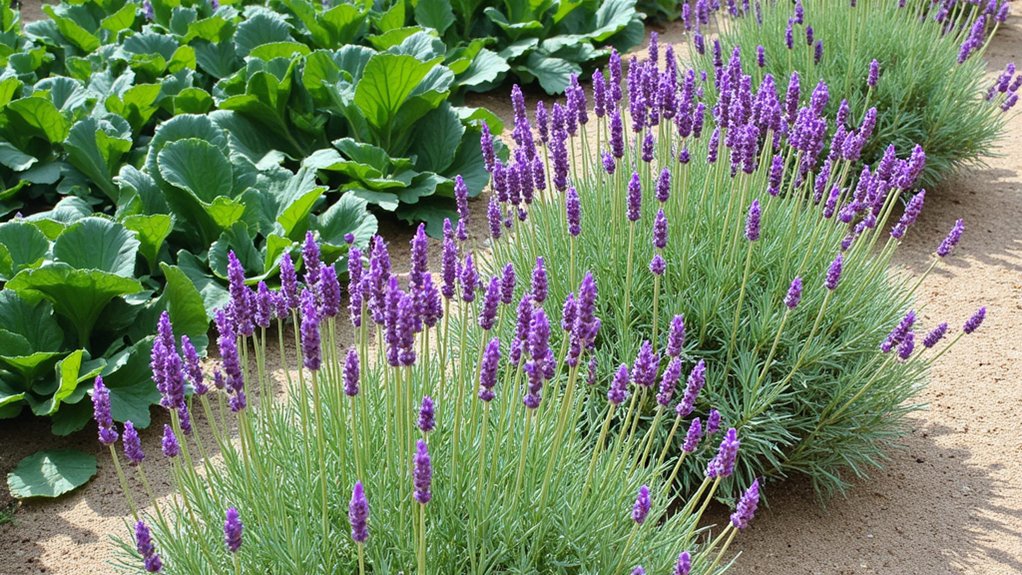
As you build your pest-resistant garden, let’s explore using lavender for natural deterrence. This aromatic herb isn’t just pretty; it’s a powerhouse against pests. Plant it near veggies like cabbage or carrots, and you’ll see fewer aphids and moths.
Space lavender plants about 12-18 inches apart in well-drained soil, ideally in full sun. They thrive with 6-8 hours of direct light daily, so pick a bright spot. Once established, usually after 2-3 months, their strong scent repels unwanted bugs naturally. Water them sparingly, only when the soil’s dry, to avoid root rot.
Check for blooms in late spring to early summer, around June or July. Trim spent flowers to keep the scent strong, ensuring ongoing pest deterrence in your garden.
Neem Tree Protection

Now that you’ve got lavender in place, let’s plunge into neem tree protection for your pest-resistant garden. Neem trees, with their natural pest-repelling properties, are a fantastic addition. They produce azadirachtin, a compound that messes with insect growth.
Start by planting a neem tree in a sunny spot, ideally 10-15 feet from other plants. Space it out, as it grows up to 50 feet tall over time. Water it deeply once a week, about 2-3 gallons, especially during the first year.
You can also use neem oil, extracted from its seeds, as a spray. Mix 2 tablespoons with a gallon of water, then apply it to plants every 7-14 days. This keeps pests at bay without harsh chemicals.
Garlic Pest Repellent

Let’s explore garlic as a pest repellent for your garden. You’ve probably got garlic in your kitchen, but did you know it’s a powerhouse against pests? Its strong smell repels aphids, beetles, and even slugs, keeping your plants safer.
Here’s how you can use it, step by step. Crush 4-5 garlic cloves, mix them with a quart of water, and let it sit for 24 hours. Strain the liquid, pour it into a spray bottle, and apply it to your plants’ leaves every 3-4 days, especially after rain. Focus on the undersides where pests hide.
This natural solution works fast, often within a day. Reapply weekly to maintain protection. You’re now equipped to fend off garden invaders with garlic!
Basil Pest Control

Ever thought of basil as more than just a pizza topping? Well, it’s a secret weapon against garden pests, and you can use it! Basil repels annoying insects like mosquitoes and flies with its strong aroma.
Plant basil near your tomatoes or peppers, about 12-18 inches apart, to maximize its pest-repelling power. Its scent confuses pests, so they’ll steer clear of your crops. Make sure you’re planting it in well-drained soil with full sun, ideally 6-8 hours daily.
Check your basil weekly for aphids; if you spot any, blast them off with a hose. Pinch off damaged leaves to keep the plant healthy. With basil in your garden, you’re not just cooking better—you’re outsmarting pests without chemicals!
Mint Pest Barrier
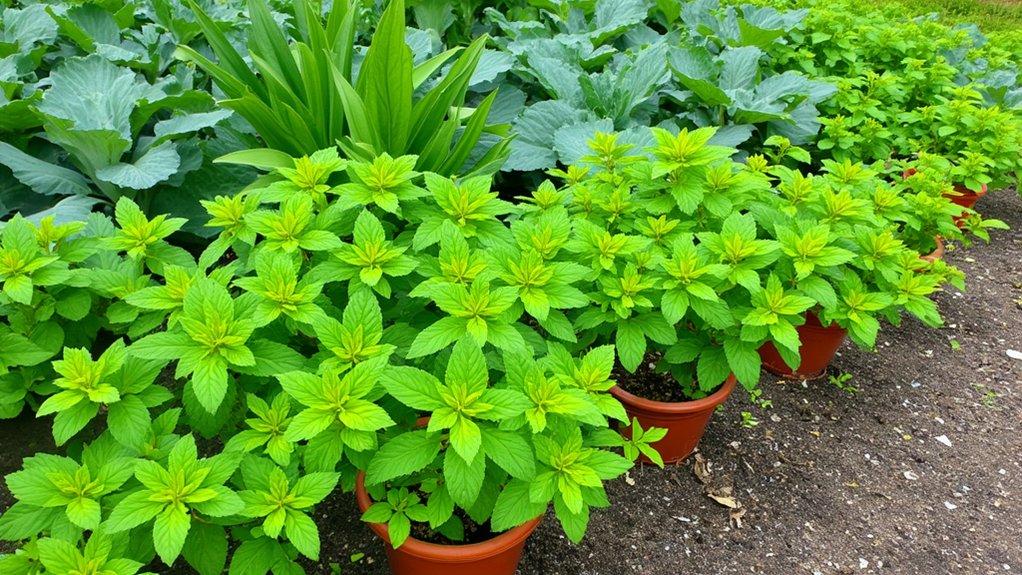
Count on mint as one of your garden’s toughest defenders against pests. This hardy herb, with its strong aroma, repels ants, fleas, and even mice. Plant it strategically, and you’ll create a natural barrier.
Start by placing mint around your garden’s perimeter, spacing plants about 18-24 inches apart. It grows fast, often spreading within a month, so use pots or barriers to control its roots. Sink containers into the soil, leaving a 2-inch rim above ground, to keep it contained.
Also, tuck mint near vulnerable crops like cabbage or tomatoes. Its scent, especially when leaves are crushed, drives pests away without chemicals. Check weekly, trimming overgrowth, to maintain its pest-repelling power. You’ve got this!
Rosemary Pest Defense
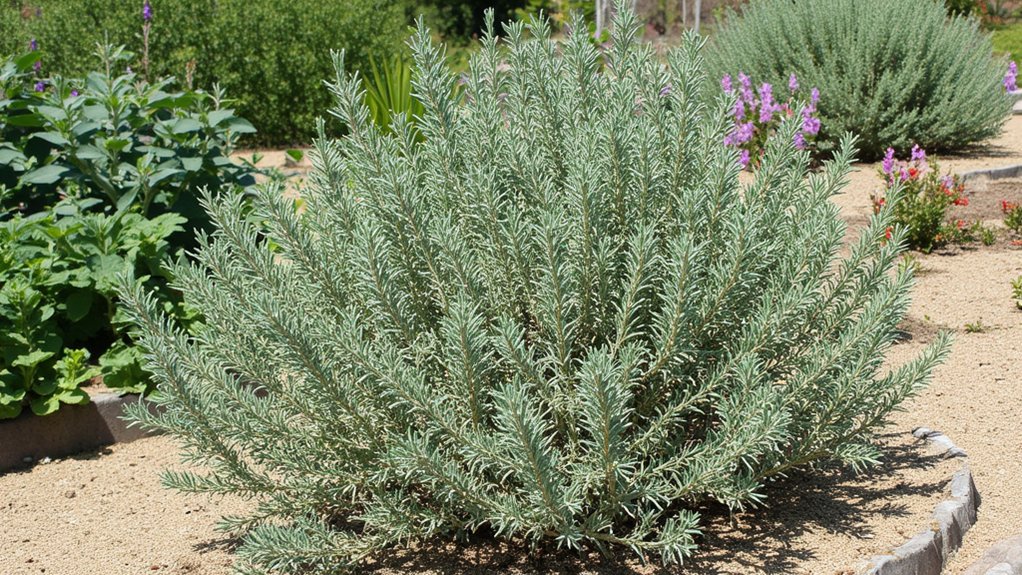
While mint offers a solid shield, rosemary steps up as another powerful ally in your pest-resistant garden. You’ll love how its strong, woody scent repels pests like mosquitoes and cabbage moths. Plant it near vulnerable crops, and watch the bugs scatter.
Here’s how to do it right: place rosemary in full sun, spacing plants about 2-3 feet apart for good airflow. Use well-draining soil, ideally sandy, and water sparingly—once every 7-10 days should do. It’s tough, so don’t fuss over it too much, but trim it yearly to keep growth bushy.
Position rosemary along garden borders or near patios for max impact. You’re not just growing a herb; you’re building a natural pest barrier with style. Stick with this, and your garden’s defense gets stronger.
Chive Pest Protection
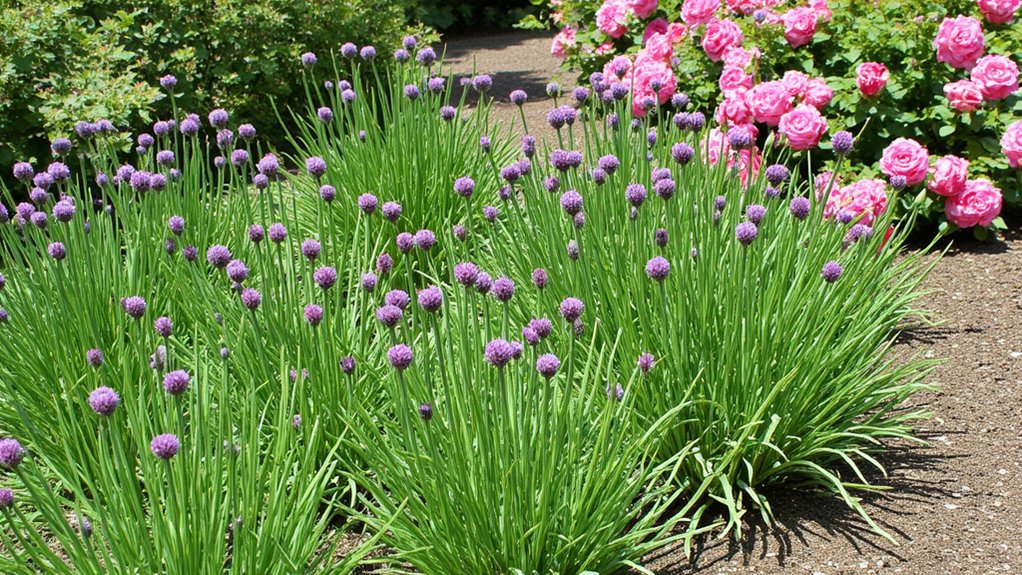
As you build your pest-resistant garden, let’s talk about chives, a small but mighty defender against unwanted bugs. These slender, green shoots aren’t just tasty; they’re a natural pest repellent, especially for aphids and Japanese beetles.
Plant chives near your vulnerable crops, like roses or carrots, spacing them about 12 inches apart. Their strong, onion-like scent confuses pests, driving them away before damage starts. Make sure you sow seeds or transplant seedlings in early spring, in well-drained soil with full sun.
Check your chives weekly for growth, trimming them to 6 inches to encourage bushiness. By doing this, you’ll maintain their vigor and pest-repelling power. So, grab some chives, plant ‘em strategically, and watch those bugs scatter without harsh chemicals!
Thyme Pest Resistance
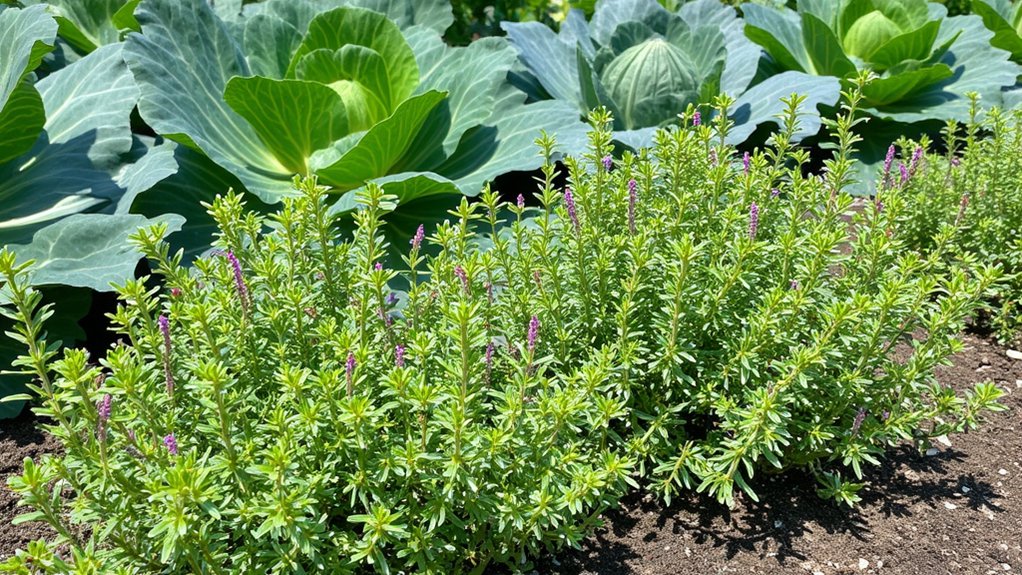
Moving on to thyme, let’s explore another powerhouse for your pest-resistant garden. You’ll love how this herb, with its strong aroma, repels pests like cabbage worms and whiteflies. Plant it near vulnerable crops, and watch it work its magic.
To get started, choose a sunny spot—thyme needs at least 6 hours of direct sunlight daily. Space your plants about 12 inches apart, ensuring good air circulation to prevent mold. Water sparingly, only when the soil feels dry, as thyme thrives in well-drained conditions.
Now, pair it with veggies like broccoli or cabbage for maximum pest protection. You’re not just growing herbs; you’re building a barrier. Check weekly for any signs of stress, and trim regularly to keep it bushy and effective.
